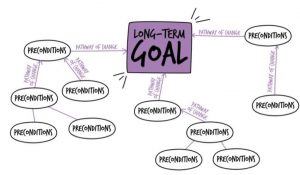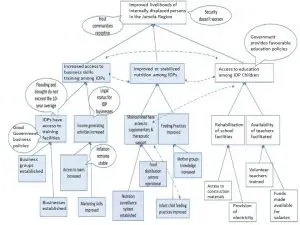Why theory of change is important in monitoring & evaluation is because it is a tool used to develop the logic model for a project or program. A logic model is a simplified picture of how a project is supposed to work. In practice, a project’s logic model is not a single document; it is a set of documents created using a collection of tools of which the theory of change is one of them. There are three tools commonly used to create project logic models:
- The theory of change (ToC)
- The results framework (RF)
- The logical framework (logframe)
Each logic model (ToC, RF, logframe) draws and builds on the information found in the previous models. That is why it is best to create them in sequence. Let us explore what is the theory of change in monitoring and evaluation.
What is a Logic Model?
A logic model is a systematic, visual way to present a summarized understanding of the ultimate purpose of the project and how it will be achieved. It identifies the ultimate purpose of a project and how it is expected to be achieved.
A logic model should help you determine:
- The desired long-term change you want to achieve.
- How the change will take place
- Assumptions needed to hold true for the change to occur
- Ways to measure and track progress
These are the questions that the logic model answers, and these are the questions you should ask when planning for Monitoring, Evaluation, Accountability, and Learning (MEAL). That is why developing logic models is important as a first step in designing MEAL for your project.
A strong logic model identifies the project logic and answers the fundamental questions related to MEAL in your project. A project’s logic model is not a single document; it is a set of documents created using a collection of tools. Strong logic models are fundamental to designing MEAL for your project, but they do much more!
While MEAL teams use logic models as principle input when designing MEAL systems, the information contained in logic models is used by many other stakeholders for multiple purposes.
Theory of Change
Theory of Change is important in Monitoring & Evaluation. The ToC is a comprehensive and visual description of how and why a desired change is expected to happen. It provides the big picture of the intended change, including
- Changes that will be made directly by your project
- Other changes that are not the direct responsibility of project activities, but that need to take place to achieve a long-term goal.
Characteristics of a good ToC
- It helps frame the long-term goal of a project and the broad strategic initiatives of intervention.
- It maps the building blocks or preconditions that need to be in place for the long-term change to occur.
- It identifies the assumptions that need to hold true for the project to succeed.
- It provides the evidence that is available to support assumptions.
The Theory of Change Format
ToCs come in many shapes and sizes. Some are quite simple and others are complex, but most are developed using a visual format. ToCs are commonly supported with graphics, including flow charts, maps, network diagrams, and tables. The ToC may also include text.
Different donors may have their own specific requirements for developing a ToC.
There are various advantages of presenting the ToC in a visual format. These include:
- Making it easier to understand complex data and ideas.
- Identify all the changes needed to achieve the intended impact including changes by other stakeholders
- Come up with the assumptions and potential risks that may make it difficult to achieve the logic of the project
- Helping initiate discussion and participation allowing for interrogation of the assumptions and suggestions on other alternatives
How to Create A Theory of Change
A theory of change (ToC) is composed of the following standard components:
- Long-term change or goal
- Preconditions and pathways of change
- Assumptions
- Connections between the pathways of change
A ToC is developed through the process of adding the components one by one. The process of developing a ToC begins with stating the long-term goal and adds preconditions, pathways of change, assumptions, and connections between the pathways of change.
Here is an overview of the ToC development process, considering each of the components of the ToC.

-
Long-term Goal
Start development of the ToC by stating the long-term change or goal. This is the desired lasting impact that the intervention aims to support. That is why Theory of Change is Important in Monitoring & Evaluation.
-
Preconditions and pathways of change
Next, add the preconditions and pathways of change. Preconditions and pathways of change are added to the long-term goal. Preconditions are the building blocks of the ToC—the requirements that must exist for the long-term change to take place. Determine the preconditions through a “backwards mapping” process.
Start with the long-term change and ask what preconditions are required in order to achieve that change. Using this process, you should identify one or more areas, or domains, of change that will contribute to the long-term change. Include the domain (s) in the ToC. Domains of change are the broad strategic areas of intervention that most directly contribute to achieving the long-term goal of the ToC.
Once you have identified the domains of change, continue to work backwards, identifying the preconditions that will lead to success in each domain. Then, organize the preconditions into pathways of change which identify the connections between preconditions and their relationship to each other.
-
Assumptions
Next, determine whether there are any assumptions that will seriously affect the project’s ability to deliver on its commitments. Ask, “What are the top three assumptions that need to be valid for our project to be successful?”
For example, you might assume that:
- The government policies will support your efforts and work
- You will have a stable political environment
- You will have partners to support you in implementing the project
- The beneficiaries of the project outcomes are interested and motivated, and they have time to engage
Assumptions provide a reality check for the ToC. They point out the potential risks that can interfere with project success. If an assumption proves to be incorrect, it can completely alter how, or even if, the project works.
When you identify a ToC assumption, look for evidence to support it. From the evidence you find, you need to assess whether you expect the assumption will hold true, whether you expect it is likely to hold true, or whether you expect it will not hold true. Depending on which of the three categories your assumption falls in, your next step will vary:
-
Will Hold True
If evidence indicates that an assumption will almost certainly hold true, then you probably don’t need to include it in the ToC.
-
Likely To Hold True
If evidence indicates that the assumption is likely to hold true, but there is some risk, then include it in the ToC and commit to monitoring its status.
-
Will Not Hold True
If evidence indicates that the assumption will NOT hold true, redesign this part of the project.
If there are no options to redesign the project, then the project may not be viable.
If you are unable to find evidence relating to an important assumption, you may need to decide how best to gather evidence so that you can determine into which of the three categories the assumption resides.
Connections between the pathways of change
Finally, look at connections between the pathways of change. You may find that some preconditions contribute to more than one pathway of change in the ToC. Represent the connections between these preconditions using dashed lines across pathways of change, indicating the need for coordination. With these components in place, you have a project ToC.
Example – Theory of Change
We are going to have Change Life, an organization that focuses on livelihood, as a use case in developing a theory of change. They have been asked by a donor to participate in an initiative designed to meet the needs of internally displaced persons (IDPs) in the Jumofa region.
Change life has a strong network of partners that includes government ministries, NGOs, and community-based organizations. Now the donor has asked Change Life to contribute to the development of a ToC that maps out its intervention strategy for the proposed IDP initiative. Fabiana the Program Manager at Change Life has led a team in developing a Theory of Change as shown below:
Steps of creating ToC
- Identify the long-term change – In this case, it was identified to be ‘Improved livelihoods of internally displaced persons in the Jumofa Region’.
- Preconditions and pathways of change – Identify the domains of change or broad strategic areas of intervention – Change Life identified three strategic areas that will most directly contribute to achieving the long-term goal of the ToC:
I. Increased access to business skills training among IDPs
II. Improved or stabilized nutrition among IDPs
III. Access to education among IDP children
“Increased access to business skills training among IDPs,” is the strategic area chosen for Change Life by the funder. The other two domains, II and III, will be the responsibility of other partner organizations.
Once they identified the domains of change or strategic areas, the team worked backward, identifying the preconditions that will lead to success in each domain. Then they organized the preconditions into pathways of change.
The illustration below shows the preconditions and pathways of change for the domain of change assigned to Change Life: “Increased access to business skills training among IDPs.”

ToC Best Practices
Theory of Change is Important in Monitoring & Evaluation. A ToC is developed through the process of adding the components one by one. However, there are some broader guidelines and best practices to consider too. Here are best practices:
- Base it on a Comprehensive Assessment
The ToC should be based on a wide-reaching, comprehensive assessment of needs, assets, opportunities, and the operating environment;
- Make it Participatory
The process of developing and validating a ToC should be participatory, involving a cross-section of staff (management, technical/sector experts, and MEAL) and key stakeholders. This way, the process can benefit from their many perspectives.
- Use Evidence-based Conceptual Frameworks
To make a strong ToC you need evidence based on research, theory, practice, and experience. As you begin defining your ToC, identify any existing conceptual frameworks that can inform your work. A conceptual framework is a tested, evidence-based model for a development or relief intervention.
A conceptual framework is used to explain how change happens in a program area.Review your donor’s requirements to see if the donor requires you to use a specific conceptual framework. For example, the USAID Office of Food for Peace (FFP) program requires that food security activities use its Adapted Food Security Conceptual Framework.
If the donor does not require the use of a specific conceptual framework, you can use an existing framework or create one. Some examples of commonly used conceptual frameworks include:
O Food security: USAID FFP Adapted Food Security Framework
O Nutrition: UNICEF Conceptual Framework for Maternal and Child Undernutrition and USAID’s Multi-sectoral Nutrition Conceptual Framework
O Behavior change: FHI360 Social and Behavioral Model for Change
- Treat it as a Living Document
At some point in the project, you may find that the ToC does not accurately reflect the project context. If this happens, don’t assume that the existing ToC must be accepted and followed! It’s important not to treat the ToC as a static document. Logic models should be considered living documents, and they should be updated as needed or when new information is reported.
Revisit and test logic models throughout the life of the project to ensure they are accurate. (Donors are increasingly supportive of this kind of review process.) Depending on the project, you could do this through an annual ToC reflection event, at the project’s midpoint, or at closure. To avoid inheriting an outdated or flawed ToC for new projects, it is important to document your learning and share it with donors and other stakeholders.
As you reflect on the ToC, keep an eye out for any “blinds spots” and “prevailing myths” that may undermine the validity. These blind spots and prevailing myths are especially important to consider when developing assumptions. Blind spots are unintentional omissions in thinking while Prevailing myths are misguided assumptions like “access equals use,” “knowledge equals action,” and “activities equal outcomes.”
In practice, good logic models require several rounds of revision before they offer a summary picture of how the project works.
Summary
Why theory of change is important in monitoring & evaluation? The theory of change is part of the tools and documentation that helps in developing the logic model for a project or program. It involves coming up with long-term change or goal, preconditions, and pathways of change, assumptions and connections between the pathways of change.
A Theory of Change is developed through the process of adding the components one by one and involves observing some broader guidelines and best practices.

